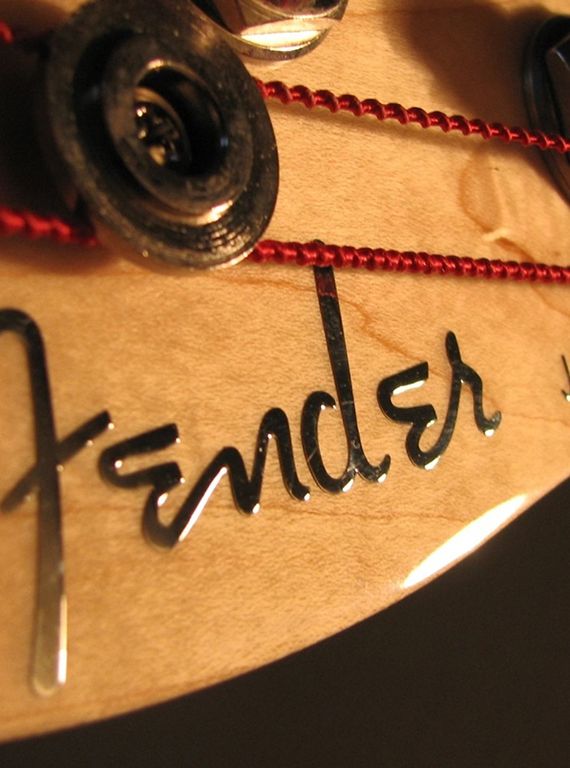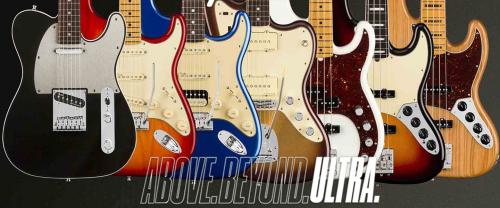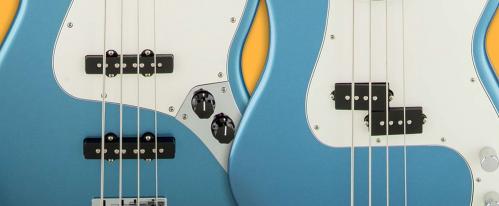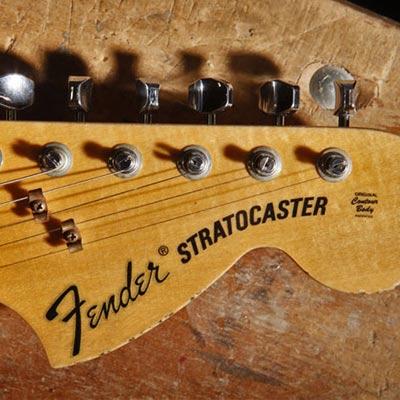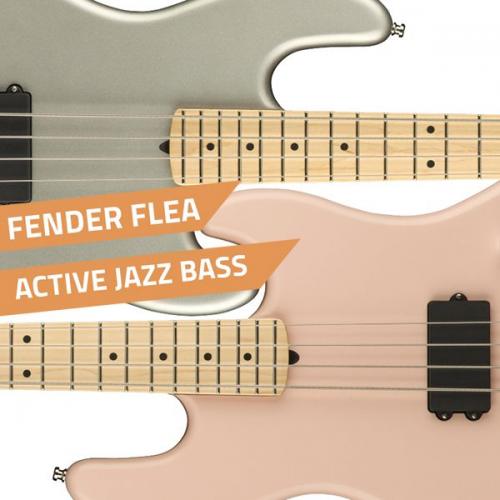SO MANY DESIGNS, SO MANY NAMES, SO MANY SPECIFICATIONS...WHAT'S THE DIFFERENCE BETWEEN ALL THOSE Fender Bass MODELS, AFTER ALL?
There really is a Fender bass guitar for everyone, but what are the differences between each model? In this blog we’re going to help you choose yours by breaking down the complex code of what’s what when it comes to the Fender bass.
Watch our Fender Bass guitar Comparison video
Don't want to read? Check out our differences between Fender bass guitars video so you can hear the unique diferences.
FENDER PRECISION BASS

We're going to start right from the beginning, with the bass guitar that changed everything.
The sound of popular music would never be the same again once the Fender Precision Bass came onto the scene. Fender’s extremely popular Precision Bass Guitar, or “P Bass” as it’s commonly known, was the first electric bass to receive widespread attention... it was revolutionary!
NOTABLE P-BASS PLAYERS
One of the most notable P Bass players is Iron Maiden’s Steve Harris, whose first bass was a Fender Precision in 1971.
Being the band’s principal composer, it’s no surprise that his incredible bass abilities and distinct galloping bass patterns are prominent in the band’s tracks.
In addition to Harris, there have been countless other notable players that made the Fender Precision their bass of choice, including Mike Dirnt (Green Day), Dee Dee Ramone (The Ramones), Pino Palladino (John Mayer Trio), and even the man many consider to be the most influential bass player of all time: James Jamerson.
With its fast neck, great sound and feel, versatility and quality, what more could you want?

The original Precision Bass, introduced in 1951 featured an alder or ash body, maple neck and a shape that was reminiscent of the Fender Telecaster, which was released 1 year earlier.
Many factors contribute to distinguishing one Fender Bass from another, the body shape, the materials, the scale, but one of the biggest differences comes from the guitar’s pickup system.
The first Precision Bass model had one single-coil pickup, which is still one of the most common pickup designs and can be spotted on a number of popular guitars, including multiple Fenders, electric guitars as well as basses.
PICKUP EVOLUTION
The use of just one single-coil is not as favourable in as many guitars as it was back in the day. “Precision-style” pickups are generally placed in the "neck" or "middle" position, but some luthiers and performers have used P pickups in the bridge position, or in between two Jazz Bass pickups.
The P Bass later received two single-coil pickups, that were offset from each other, (one under two strings), making them buck the hum, a highly desired pickup style to today.
Depending on the various specifications of the guitar, the single-coil can produce quite a vast spectrum of tones, from a strong, fat mid-heavy sound heard on some Gibsons (that feature the P-90 “soap bar” single-coil), to the clear and crisp tone produced from the Fender Telecaster.
Shortly after its birth, the P Bass was given a pretty radical upgrade, ridding it of all things Tele, Fender contoured the guitar’s edges and redesigned the body to resemble the “new and modern” Stratocaster.
Among other updates, the P Bass’ single-coil pickup was replaced by a new split-coil arrangement in 1957. This new configuration featured 2 staggered pole pieces, connected in a humbucking mode.

FENDER JAZZ BASS
The world was first blessed with the Jazz Bass back in 1960 and since, this bass has been fundamental in the development of many artists’ signature sounds in certain genres, such as Funk, Reggae and Jazz Fusion.

This Fender bass actually puts less emphasis on the fundamental harmonic, making it one of the first choice instruments for bassists who want to be more "forward" in the mix.
The Jazz Bass was initially known as the Deluxe Model, but with its narrow and rounded neck, the guitar appealed greatly to many Jazz musicians, hence the name change. Of course, changes have been made to the original model, such as the replacement of the old clay-style tuners and the introduction of block inlays and an optional maple fingerboard.
2008 saw the development of this classic bass further, with the American Deluxe models featuring 3-band EQ. You can see the various Jazz Bass models here. The original guitar featured single-coil pickups, with two pole pieces per string. This pickup configuration gave the Jazz Bass a stronger treble sound that the P. Bass, and was Fender’s attempt to compete with the “famously bright” Rickenbacker bass of the ‘50s.
THAT FAMOUS JAZZ BASS GROWL
With its bright sound and brilliant high end, the Jazz Bass was ideal for slap bass and great for fingerpicking style players too.
The Jazz Bass’ bridge pickup gives more treble, and the neck pickup yields a rounder sound with the brightness coming from the two pickups and their positions being at different points in the string’s lengths.
The Jazz bass has the ability to blend both pickups, as they have separate volume controls so you can access them individually, so the player can achieve a wider range of sounds than the P. Bass.
These pickups are reverse-wound, reverse polarity (RWRP) from each other, which means that all hum is cancelled when both pickups are at cranked all the way up.
The pickups at full volume give the classic scooped “growling” sound that many players have become fond of.
Bassists such as Will Lee (pictured to the right) would use this effect for playing slap bass, as well as some other common Jazz Bass techniques.

FENDER MUSTANG BASS

First introduced in 1966, the Mustang Bass is a cool, shorter scale alternative to its notorious big brothers. The Original Mustang Bass had a feisty mid-60s vibe and was initially available in 2 standard finishes, red and white.
In ’69, both the Mustang electric guitar and bass were given competition finishes, Red with three white stripes and Lake Placid Blue with lighter blue stripes. (The yellowing of the lacquer on some early models has also resulted in "rare" colours like Surf Green, in reality a yellowed Competition Blue).
The Fender Mustang Bass features a 30” scale neck, making it significantly shorter than the Precision and Jazz Basses.
This short scale design makes the Mustang very comfortable to play, an ideal choice for students, beginners, players with small hands and guitarists-turned-bassists.
This short scale bass features a Special Design split single-coil Mustang Bass pickup, quite similar to that of the Precision Bass.
Other special features include one volume and one tone control, its string-through-body routing, alder body and rosewood fretboard.
Two Mustang variants can be seen from time to time. The Musicmaster bass was released in the mid-60s as a student option, and featured one single-coil pickup (6-pole Strat pickup under a solid plastic cover).
Squier have produced the Vintage Modified series of Mustang Basses, as well as the Bronco Bass from fender’s Affinity Series, which is basically great for guitarists who occasionally need a bass, it tunes easily and sounds full and rich.

FENDER JAGUAR BASS
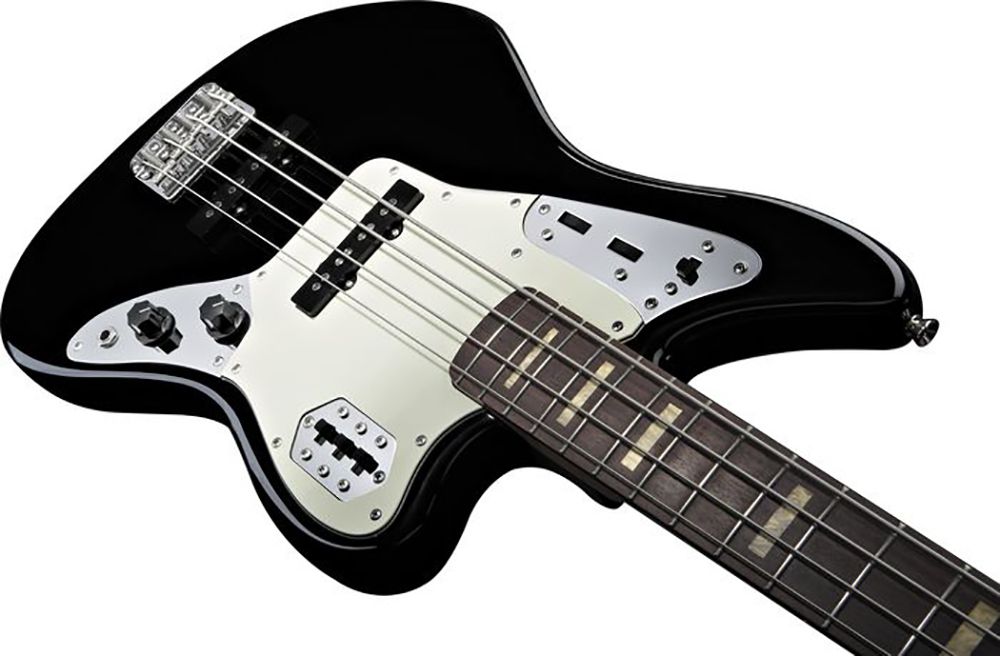
Possibly Fender’s most versatile bass, the Jaguar Bass is also one of Fender’s most recent bass models. The Jaguar Bass, manufactured in China and Japan, was unveiled at the 2006 NAMM Show and comes with some features that are bound to get a few of the guitarists among you thinking about picking one up.

Although the Jaguar bass takes its looks from the Jaguar electric guitar, its features are very similar to that of the Jazz bass.
The neck and bridge pickups are taken from the Jazz, and the Jag features quite a similar tone to this model too, with the two sharing the same recognisable “growl” that made the Jazz bass so popular in its earlier days.
So what makes this a Jaguar then... well this bass features a standard 4 saddle, vintage-style, top-loading bridge and tuners, onboard preamp, two vintage Jazz Bass single-coil pickups and on/off pickup switches.
Being a great bass guitar, Fender has made the Jaguar available to everyone, producing different models for various playing abilities.
For example, in 2010, Squier released the Vintage Modified Jaguar Bass which also became available in a ‘special’ model and an ‘SS’ (short scale) version to appeal to the diverse range of bassists.
The Modern Series Jaguar Bass was released in 2011 and the youngest model is the Mikey Way Signature, unveiled only this year and features Fender’s striking large-flake silver sparkle finish and black racing stripe, you can’t miss it.
Each of the bass guitars on this list was created for a particular player, all top particular requirements, with particular specifications, and particular purposes... But whichever Fender bass you end up with, you'll know where it came from, and you'll know just what it's capable of!
Updated: 2020-07-02

